Life feels very different now than it did just a few weeks ago, but as many countries enter their fourth week isolating at home, we are adjusting to our new normal. Duolingo employees are now all working remotely, from our homes across the U.S. and around the world, with the exception of our Beijing office — in China, things are slowly, hesitantly, returning to normal.
Our learners, too, are adhering to shelter-in-place orders and developing new strategies to fill the days. For many around the world, Duolingo has become a part of their new at-home routine: from learning a language to feel connected to people a world away, to using Duolingo while schools and educators scramble to transition to online teaching, to building healthy new habits that create a sense of normalcy in our new routines. One of our key initiatives was creating a guide for parents and educators (athome.duolingo.com) with ideas for language-learning games and lessons that you can use at home.
In this post, we'll be sharing some of the ways in which Duolingo learners and learning behaviors have changed due to coronavirus. Learning a new language isn't just a fun, productive habit to pass the time; for our learners, language is a bridge between people enduring the same uncertainty, all around the world.
Changes in learning with Duolingo during the global pandemic
- Learning on Duolingo is at an all-time high. New users on Duolingo doubled over the month of March, with the biggest surge coming the week of March 16, after the World Health Organization declared a global pandemic.
- Learners respond swiftly to government-ordered isolation. The U.S., France, and Spain began implementing stay-at-home guidelines earlier than the U.K. New Duolingo users spiked the week of March 16 in the U.S. (66% more new users than at the end of February), France (107% more new users), and Spain (109% more new users). The U.K. spike came the following week, on March 23, with 296% more new users compared to the end of February.
- Duolingo steps in to support online classrooms at home. Worldwide, we've seen an increase in the proportion of users studying with us for school: in March 2020, over 30% of new learners were using Duolingo for school, and travel had dropped to the third most common reason for study, with less than 13% of new learners.
- Learners choose languages they can apply. Learners in English-speaking countries are largely focused on Spanish and French, and learners in non-English-speaking countries are using time at home to study English.
- Learners spend more time studying and don't take weekends. New learners spend 13% more time on Duolingo than was typical for new users in the past, and they study as much during the week as they do on weekends. We also see an increase of as much as 2.5 as many lessons completed midday, especially just before and after lunchtime.
Next we'll look more closely at these numbers and what they can tell us about how users' motivations and learning preferences have changed due to the pandemic.
Learning on Duolingo is at an all-time high
Global traffic on Duolingo soared in March, as COVID-19 spread across the globe and as more countries began implementing stay-at-home orders and closing businesses and schools. Over the month of March, new users on Duolingo increased by 101%. The increase in new users was especially sharp from March 9 to March 16, the week in which the World Health Organization labeled the virus a global pandemic: growth in new users was 39% from one week to the next.

Learners respond swiftly to government-ordered isolation
COVID-19 first surfaced in China in December 2019, and government responses to the disease have rippled across the globe since then. Our data indicate that learners respond in significant ways to the speed and clarity of government-ordered isolation measures.
Among new Duolingo users in English-speaking countries, we see big differences between the U.S. and the U.K. The U.S. began implementing stay-at-home guidelines earlier than the U.K., and so there was a spike of new Duolingo learners the week of March 16, with 66% growth compared to new users at the end of February. Soon thereafter, the U.K. government changed their approach to the pandemic, and so the U.K. spike in new users came the following week, on March 23, with 296% more new users than at the end of February. Because each U.S. state has issued its own guidelines, growth in new users in the U.S. isn't as sharp and uniform as we see in the U.K., which implemented more sudden, uniform guidelines.
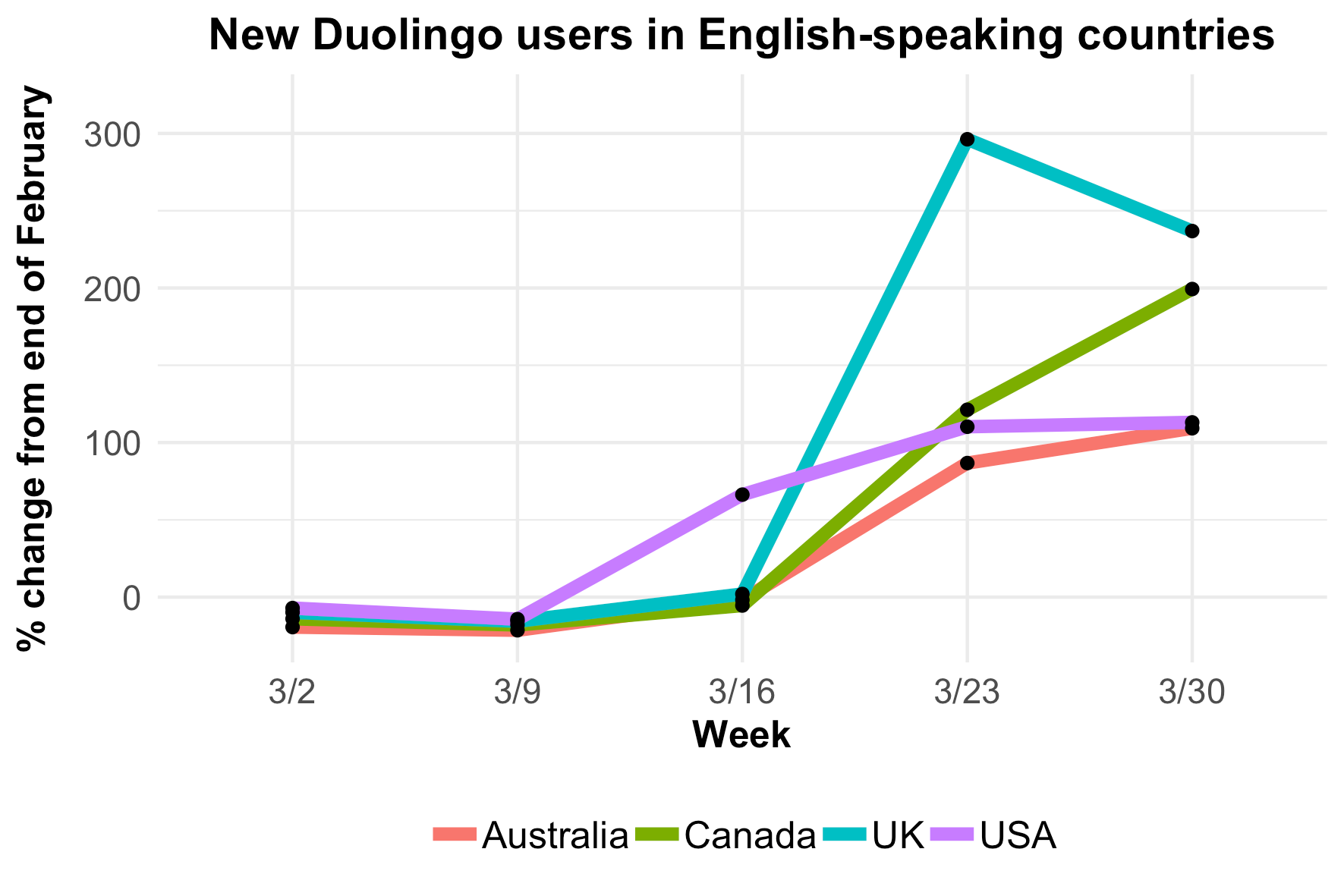
New users in Europe are also responding to how the crisis has evolved in their own countries. Growth began spiking earlier in Italy than in other parts of Europe. There, COVID-19 was initially localized in northern Italy, but as the whole country began responding to the disease, learners across Italy who are staying at home have begun using Duolingo during isolation.
France and Spain also implemented stay-at-home guidelines in mid-March, after the WHO labeled the crisis a pandemic. The number of new Duolingo users in these countries grew sharply on March 16; as a result, new users in France increased 107% and new users in Spain increased by 109% compared to the end of February.
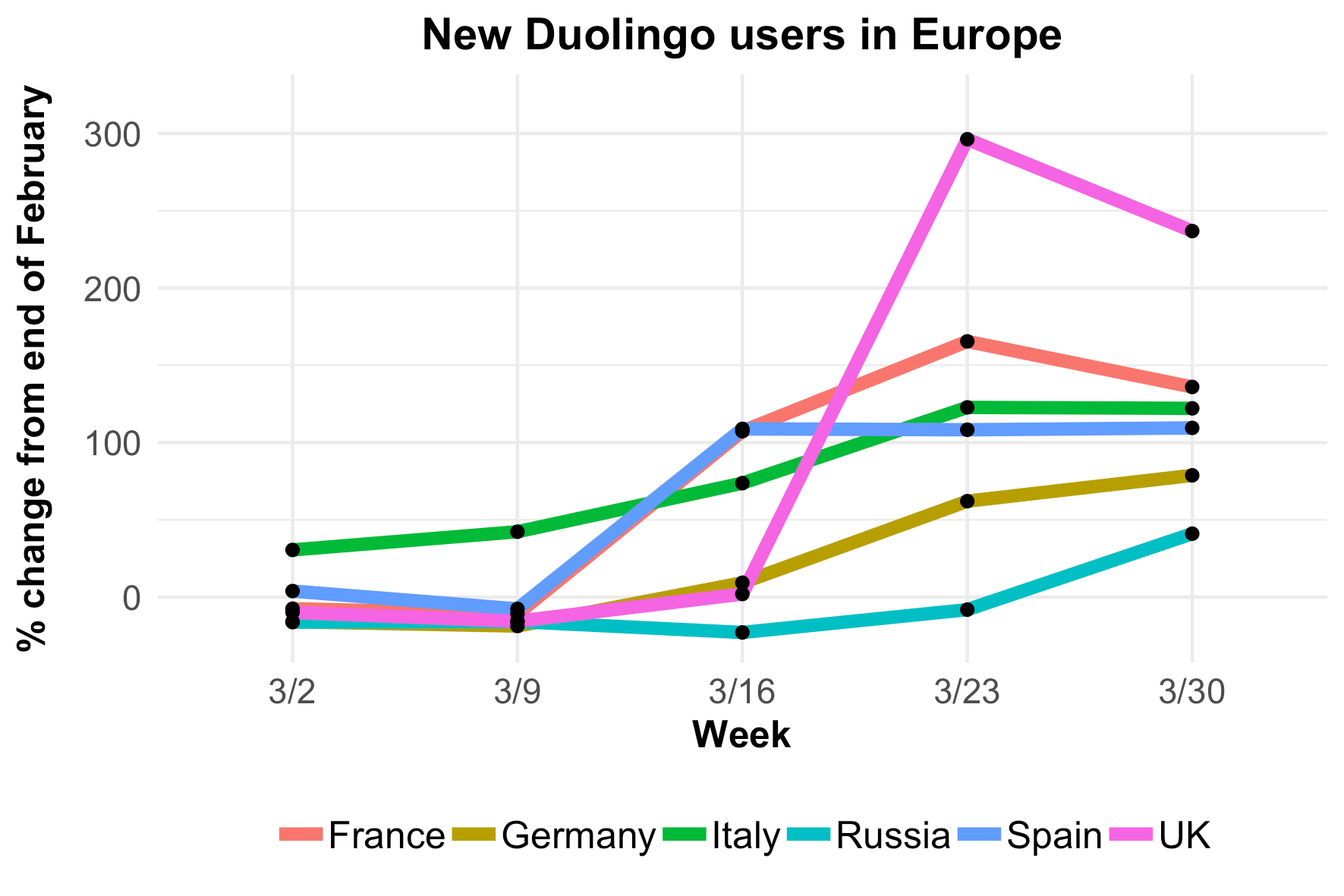
There has also been significant growth in new users in Latin America, especially around March 23. At this point, new users had spiked 82% in Mexico, 91% in Chile, 92% in Peru, and 92% in Brazil compared to the end of February. In Argentina, a whopping 292% more new users joined compared to the previous month.
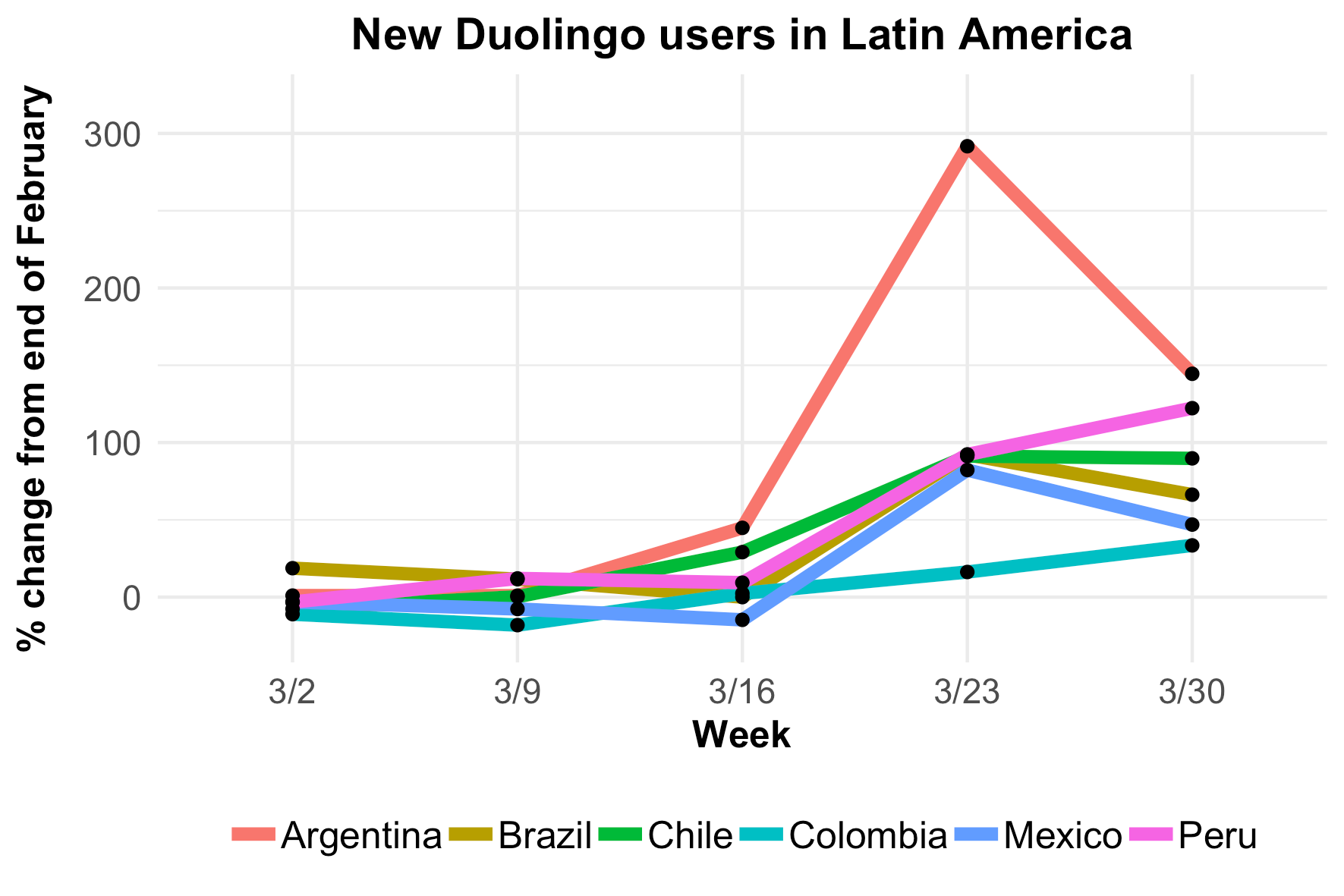
COVID-19 hit China first, and isolation measures on February 20 led to 456% more new users in China compared to the end of January. More recently, in March, learners in Asia continued the language-learning habits they had developed during the earlier stages of the pandemic. Our data indicate continued growth in Korea, with 45% more new users on March 9 than at the end of February, and a later spike for Vietnam, with 24% more new users on March 16 than at the end of February.
In India, the pandemic and government response are more recent: the country issued a lockdown order at the end of March, but with the health crisis looming, Indians began responding on their own even earlier. By March 23, new Duolingo users in India skyrocketed over 108% compared to the end of February, and interest in learning with Duolingo continued to surge past 320% during the final week of March!
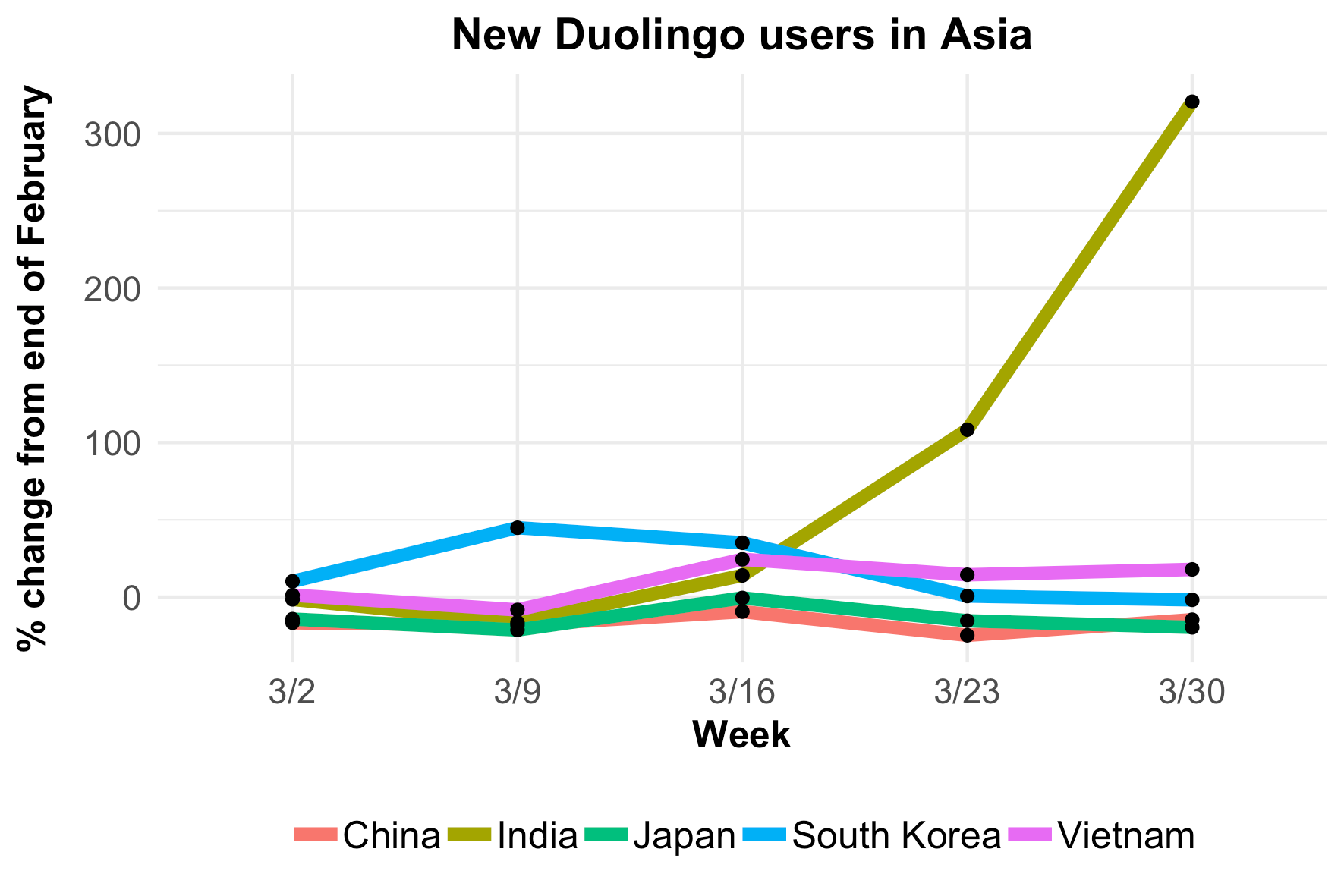
Duolingo steps in to support online classrooms at home
Classroom language learners have long turned to Duolingo as a tool to complement school lessons and give them a fun, varied way to learn a language on their own time, at their own pace.
Worldwide, we've seen an increase in the proportion of users studying with us for school. In March 2020, over 30% of new learners told us they were using Duolingo for school (7% higher than normal). Brain training rose to the #2 position, with over 15% of new users using Duolingo to keep themselves sharp and engaged. Travel dropped to #3, with less than 13% of learners.
Studying for school has been an especially important factor in countries that have implemented stay-at-home policies. School use has been most notably on the rise in Mexico: Mexico had the highest proportion of school learners in the world in 2019, and that trend continued during the March surge as school learners made up more than 50% of new users in Mexico.
Other countries have also recently seen dramatic increases in school users. Chile and France both saw increases to over 40% of new users studying for school. The U.S. and U.K. also saw large jumps in school users at the peak of the new user spike: U.S. school use grew by 11% and U.K. school use by over 15%.
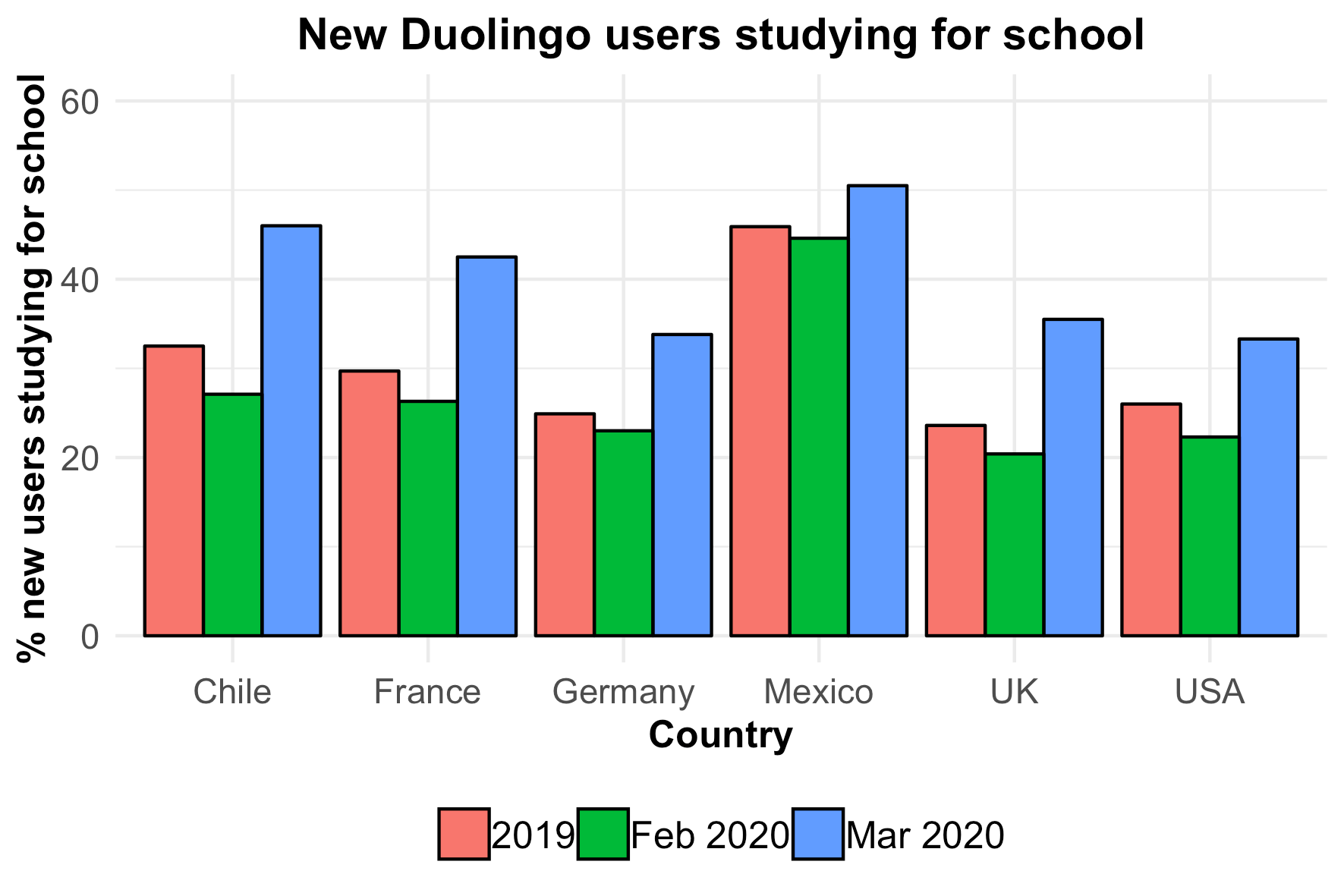
Learners choose languages they can apply
Since new learners are using Duolingo to supplement their schoolwork, users are focused on studying English, Spanish, and French. Learners in English-speaking countries are largely focused on Spanish and French, while those in non-English-speaking countries are studying English even more than usual. Most countries have also seen a decline in studying the nation's own language: in the U.S., 19% of new users in February chose to study English on Duolingo, but only 11% chose English during the peak of new users in March.
Several countries have even seen an increase in learners focusing on the languages associated with socioeconomic opportunity. In the U.S., Spanish learners have grown more than 5% between February 2020 and isolation measures in mid-March. The U.K. has seen a similar pattern: English learning is down nearly 6%, while Spanish learning is up 6% among new users and French is up nearly 10%.
There are some interesting exceptions across the globe. Most notably, new learners in Ireland did not join Duolingo in March to study Spanish or French, like their neighbors in the U.K. did. Instead, the proportion of learners studying Irish has nearly doubled: during the initial stay-at-home order, 43% of new learners in Ireland were studying Irish.
Learners spend more time studying and don't take weekends
Overall, learners are spending 7% more time on Duolingo now than was typical just a month ago, but new and existing users behave differently: learners who have joined Duolingo during the global pandemic spend 13% more time on Duolingo than was typical for new users in the past, and they study as much during the week as they do on weekends. Many learners used to take advantage of daily commutes to do a few lessons, but now we see an increase in midday language study, especially just before and after lunchtime.
France and Italy have seen some of the biggest changes in learners' behavior. New learners in these countries spend at least 23% more time studying on Duolingo than they did in February, and learners in both countries now study consistently across weekdays and weekends. They also do 1.5 to 2 times as many lessons between 10am and 5pm as was typical pre-COVID-19. An exception to this general pattern is the U.K., where new learners continue to maintain different weekday and weekend study habits, but they are completing as many as 2.5 times more midday lessons as was the norm.
Helping learners adapt to the new norm
The trends we've noted in our data indicate that at-home language learning is at an all-time high as a way to connect with the speakers and cultures we love, and to keep up learning when so much feels out of our control. As the situation changes, we expect learner behavior to change as well, and we'll continue to report on how language learning fits into our new lifestyles.
